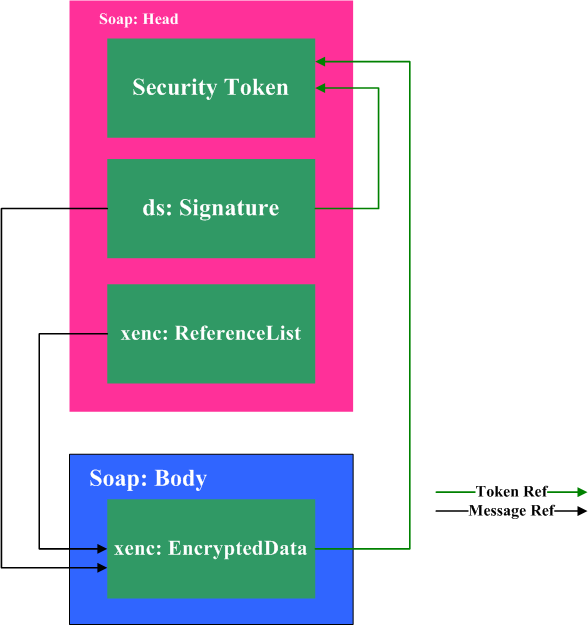在分别介绍了XML Signature和XML Encryption后,我们了解了如何用XML的形式来保证消息的完整性(Integrity)和机密性(Confidentiality)。如何将其运用到Web Service中从而保证Web Service的安全性,这就是WS-Security规范所描述的内容。我们知道Web Service的采用SOAP作为消息封装协议, 因此WS-Security规范主要描述了如何将XML Security(XML Signature和XML Encryption)与已有的安全技术(Kerberos,X.509,SAML)结合, 并把它们绑定到SOAP中.
<S:Envelope>
<S:Header>
<wsse:Security>
<!-- Security Token -->
<wsse:UsernameToken>
...
</wsse:UsernameToken>
<!-- XML Signature -->
<ds:Signature>
...
<ds:Reference URI="#body">
...
</ds:Signature>
<!-- XML Encryption Reference List -->
<xenc:ReferenceList>
<xenc:DataReference URI="#body"/>
</xenc:ReferenceList>
</wsse:Security>
</S:Header>
<S:Body>
<!-- XML Encrypted Body -->
<xenc:EncryptedData Id="body" Type="content">
...
</xenc:EncryptedData>
</S:Body>
</S:Envelope>
以上是一个典型的使用WS-Security协议来保证SOAP消息安全的例子。从中可以看出WS-Security协议主要对SOAP消息的Head部分做了扩展---加入了wsse:Security元素。其中针对安全的三个方面Authentication, Integrity, Confidentiality分别定义了Security Token, XML Signature以及XML Encryption Reference List三个子元素。而在SOAP包中的需要加密的业务内容(通常会加密整个Soap Body)被经过XML Encryption处理过的元素(EncryptedDate)所替代。
下面这张图大致描述了WS-Security所包含的元素以及它们之间的关系。

(注意这幅图只是一张示意图,比如ds:Signature也可以对Soap Head中的元素做签名)
从之前对XML Signature和XML Encryption介绍中,我们已经了解了签名和加密的具体过程,以及在整个过程中产生的各个元素的含义。下面就从一个具体的运用了WS-Security规范的Soap Envelop中来看看如何在WS-Security中使用XML Signature和XML Encryption。
<?xml version="1.0" encoding="utf-8"?>
<SOAP-ENV:Envelope xmlns:SOAP-ENV="http://www.w3.org/2001/12/soap-envelope"
xmlns:ds="http://www.w3.org/2000/09/xmldsig#"
xmlns:xenc="http://www.w3.org/2001/04/xmlenc"
xmlns:wsu="http://schemas.xmlsoap.org/ws/2002/07/utility">
<SOAP-ENV:Header>
<wsse:Security
xmlns:wsse="http://schemas.xmlsoap.org/ws/2002/secext">
<wsse:UsernameToken wsu:Id="UserToken">
<wsse:Username>HotelService</wsse:Username>
<wsse11:Salt>sdfer..</wsse11:Salt>
<wsse11:Iteration>1000</wsse11:Iteration>
</wsse:UsernameToken>
<ds:Signature>
<ds:SignedInfo>
<ds:CanonicalizationMethod
Algorithm="http://www.w3.org/2001/10/xml-exc-c14n#"/>
<ds:SignatureMethod
Algorithm="http://www.w3.org/2000/09/xmldsig#hmac-sha1"/>
<ds:Reference URI="#DiscountedBookingForPartnersResponse">
<ds:DigestMethod Algorithm="http://www.w3.org/2000/09/xmldsig#sha1"/>
<ds:DigestValue>JwFsd3eQc0iXlJm5PkLh7...</ds:DigestValue>
</ds:Reference>
</ds:SignedInfo>
<ds:SignatureValue>BSxlJbSiFdm5Plhk...</ds:SignatureValue>
<ds:KeyInfo>
<wsse:SecurityTokenReference>
<wsse:Reference URI="#UserToken"/>
</wsse:SecurityTokenReference>
</ds:KeyInfo>
</ds:Signature>
<xenc:ReferenceList>
<xenc:DataReference URI="#DiscountResponse"/>
</xenc:ReferenceList>
</wsse:Security>
</SOAP-ENV:Header>
<SOAP-ENV:Body wsu:Id="DiscountedBookingForPartnersResponse">
<s:GetSpecialDiscountedBookingForPartnersResponse
xmlns:s=?http://www.MyHotel.com/partnerservice?>
<xenc:EncryptedData
wsu:Id="DiscountResponse"
type="http://www.w3.org/2001/04/xmlenc#Element">
<xenc:EncryptionMethod
Algorithm="http://www.w3.org/2001/04/xmlenc#aes256_cbc "/>
<ds:KeyInfo xmlns:ds='http://www.w3.org/2000/09/xmldsig#'>
<wsse:SecurityTokenReference>
<wsse:Reference URI="#UserToken"/>
</wsse:SecurityTokenReference>
</ds:KeyInfo>
<CipherData>
<CipherValue>XDsFaDWsHdhrHdhcW0x...</CipherValue>
</CipherData>
</xenc:EncryptedData>
</s:GetSpecialDiscountedBookingForPartnersResponse>
</SOAP-ENV:Body>
</SOAP-ENV:Envelope>
对于其中的大部分元素我们已经比较熟悉,而wsse:UsernameToken以及在ds:Signature和xenc:EncryptedData 中出现的wsse:SecurityTokenReference子元素则显得比较陌生。
我们知道为了保证消息的完整性和机密性需要用到密钥(对称或非对称),而在它们各自的ds:KeyInfo子元素中都使用wsse:SecurityTokenReference引用到了在Soap Head最开始定义的Security Token(这里是UsernameToken)。由此可以看出Security Token是保证消息的完整性和机密性的基础,同时密钥也是用户证明身份的标志,因此包含密钥信息的Security Token也是实现身份鉴别的基础。在已经介绍过XML Signature和XML Encryption的基础上,下面对WS-Security的介绍将主要集中在Security Token上。
系列文章




【推荐】国内首个AI IDE,深度理解中文开发场景,立即下载体验Trae
【推荐】编程新体验,更懂你的AI,立即体验豆包MarsCode编程助手
【推荐】抖音旗下AI助手豆包,你的智能百科全书,全免费不限次数
【推荐】轻量又高性能的 SSH 工具 IShell:AI 加持,快人一步
· 如何编写易于单元测试的代码
· 10年+ .NET Coder 心语,封装的思维:从隐藏、稳定开始理解其本质意义
· .NET Core 中如何实现缓存的预热?
· 从 HTTP 原因短语缺失研究 HTTP/2 和 HTTP/3 的设计差异
· AI与.NET技术实操系列:向量存储与相似性搜索在 .NET 中的实现
· 10年+ .NET Coder 心语 ── 封装的思维:从隐藏、稳定开始理解其本质意义
· 地球OL攻略 —— 某应届生求职总结
· 提示词工程——AI应用必不可少的技术
· Open-Sora 2.0 重磅开源!
· 周边上新:园子的第一款马克杯温暖上架